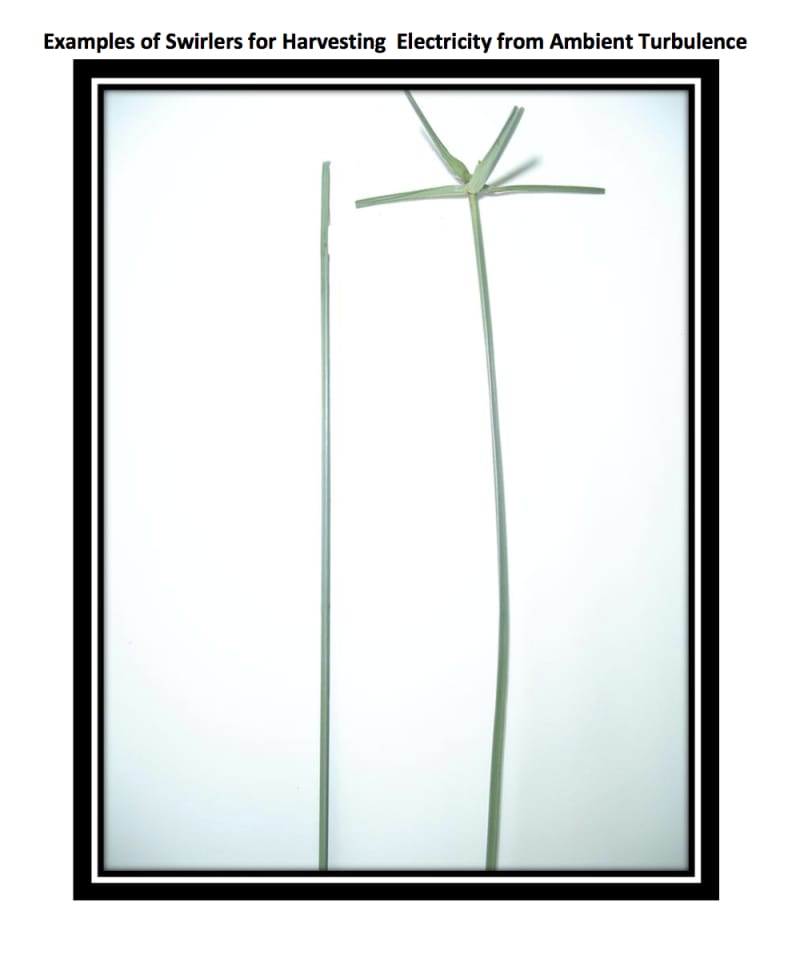Significant turbulence is created by airflow from moving vehicles. This turbulent air is an untapped, kinetic-energy resource. This turbulence is difficult to harness due to the chaotic intensity and irregular vectors of the energy. A system—HEAT—is proposed to convert this turbulence into useful electric current. This turbulence is predictable and sustainable, in that it is a product of movement of cars, trucks, trains, and the movement of air through tunnels.
The HEAT system consists of multitudes of “swirlers” which flex, bend, and sway, as they are affected by the turbulence. These movements can generate electric current as the swirlers move in response to the turbulence. The base of each swirler is anchored in a flexible, piezoelectric substrate which produces current as the substrate flexes. Swirler arrays are connected to a common circuit, where the (DC) current is used and/or stored for later uses. The HEAT swirlers would be sized to respond to situational turbulence. Swirlers will demonstrate physical attributes that allow stiffness and mass to generate maximum deformation of the piezoelectric substrate as they respond to turbulence. Different swirler designs (see Figure for two possible designs) may be required depending on the type and intensity of turbulence. For instance, the turbulence encountered in tunnels may be different than that along “Jersey walls”. Also, design modifications may be required depending on site-specific environmental factors such as weather conditions (e.g, icing), or other requirements.
Tapping turbulent energy sources can offset costs of electricity for lighting of roadway features, facilities, or operating systems. The generated current is transformed, and combined to operate lighting, ventilation fans, or other applications. Any excess electrical current generated is stored in battery systems or is returned to the electrical grid. It is expected that the capital investment in a HEAT system in most applications would be returned within three to five years. Public benefits will accrue from reduced operating expenses for transportation systems as well as improved safety and security from expanded lighting along roadways.
When a HEAT system is situated near busy roadways, there will be a fairly constant supply of turbulent energy which initially, may be directional. In tunnels, however, the HEAT system might be applied around the internal circumference using multiple, connecting arrays on the walls and ceiling to maximize turbulence-scavenging capability.
The HEAT system combines reliable and durable components with modular design to reduce production and life-cycle costs. Swirler arrays can be mass-fabricated with proven technology (e.g., piezoelectric) and inexpensive materials (e.g., carbon fiber) to reduce cost and ensure maintainability. The swirler arrays will use interlocking modules so that they can be replaced easily.
Some testing and development will be necessary to develop the optimum design and performance of the HEAT system to maximize energy production at each site. For example, the attachment points of the individual swirlers may differ according to the realities of debris accumulation, levels of turbulence and environmental factors.
Like this entry?
-
About the Entrant
- Name:Jeffrey Short
- Type of entry:individual
- Software used for this entry:none
- Patent status:none

